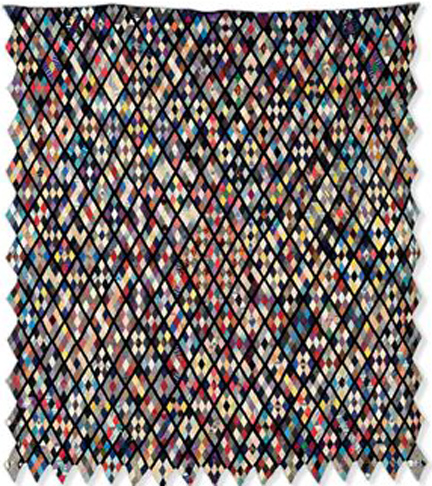I've been going through my old auction photos looking at borders as a dating clue and Virginia asked about edges. When do we start seeing shaped edges like the zig-zag above in a quilt that looks to be 1930s-40s?
Scalloped edges are a clue to a 20th century quilt. Kit quilts and companies that sold bias tape emphasized this finish.
We can give a lot of credit to Marie D. Webster who brought quilt design into the 20th century with patterns like her Sunflower.
Here's an interesting shaped edge in another Webster pattern Dutch Basket.
So when you see something like this with a scallop bound in bias you think "after 1930" although the rest of the quilt---the color, the solid fabrics, the patterns---look older. I found this great quilt in a 1987 issue of Stitch n Sew Quilts.
A classic 1930s interpretation of 19th-century design
Here's another example of a 19th-century pattern but the scalloped edge bound in pink solids makes me wonder if it's a mid-20th century quilt. The color scheme is old but the shades are new---the green is more Nile green than overdyed; the orange isn't chrome orange but true orange. So a scalloped edge is a clue---
But not a really strong clue.
You do see it in 19th century quilts. I've seen examples close-up in the cloth where the binding is definitely the same age as the patchwork.
Here's that distinctive ice cream cone border you see so much in '30s quilts around a 19th-century applique top. It could have been finished later...hard to tell from just an auction photo.
Here's the definitive answer to the question---did they do ice cream cone borders?---Jane Stickle's Civil War quilt from the Bennington Museum. See detail shots here:
You see a lot of shaped edges around silk quilts after 1880.
These loose sort of flaps are seen on late-19th century crazy quilts
Probably inspired by the concurrent fashion for wool table toppers and rugs made the same way.
Crazy quilts often had fancy edges like this doll quilt with a piece of lace attached.
Here's a fabulous string quilt from the 1880s or 90s with a scalloped edge bound with a contrasting strip.
And then there are these folded triangles we call prairie points---definitely seen in the 1880s.
Scalloped edges in a mid-19th-century quilt are not common,
but they are out there---like this amazing edge.
Finishing off an amazing pieced border.
The fabrics definitely look mid 19th-century.
One more random thought on shaped edges:
.
See Karen Griska's post on two impressive bindings here:




















Very interesting to read, especially after doing the Dear Jane border myself. It is not easy to make a shaped border, but it can give something extra to a quilt.
ReplyDeleteI love the look of shaped edges, and like the first example the best. I was wondering, with quilts that have fancier edges like the other examples, how well do they hold up over time with wear?
ReplyDeleteDebbie
It is always interesting and amazing to see what previous quilters could create without all the gadgets we have today. I agree with WoolenSails..love that first example.
ReplyDelete
ReplyDeleteHere's a note from a textile conservator about wear on shaped edges:
"I can say from experience that shaped edges are just like straight edges in terms of how they hold up. Wear and tear depends on use/abuse not the shape. The shaped ones just cost more $$ time and energy to replace. If they receive severe abuse it sometimes effects the areas of the quilt between the shapes and then sadly the shaped edge has to be removed to save the rest of the quilt."
They are just fabulous and there are many favorite.Add border to a quilt change it.Thanks for the links!
ReplyDeleteThanks Barbara - a wonderful selection and much inspiration as always :)
ReplyDeleteHilda
Barbara, I thought you might enjoy seeing one more quilt with shaped edges. My friend, Pat, has posted about a beautiful quilt she recently found. Her blog is birdnestontheground.blogspot.com. Your encyclopedia is mentioned, too!
ReplyDeleteSherry in Little Rock